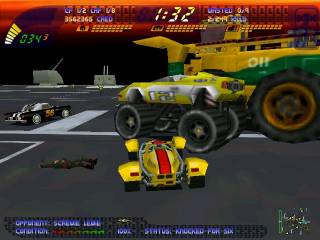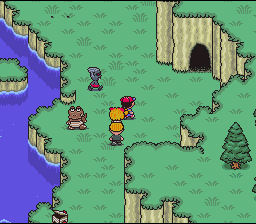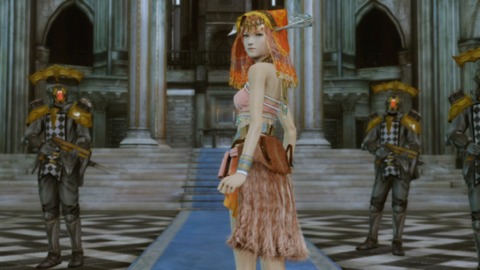Mento + The Mechanics: Part 3
By Mento 3 Comments
It's been a while since I did one of these, huh? More than a year, in fact. In another lifetime I was a game designer, so when playing a game I often find myself drawn to interesting mechanics and features the game is employing to stand out from the herd. It's not the be-all and end-all of what goes into a remarkable game, but game mechanics are the most significant "games only" factor when creating within this particular medium. If a game's got a great plot, relatable characters, wonderful visuals or clever sound design then I'm all for seeing any or all of that in a game and happy to recommend it and its solid fundamentals to others, but those are all central tenets of movies, live theater and television as well.
Conversely, deeper video game mechanics, especially those designed to be highly intuitive or add to the experience in a subtle "behind the scenes" manner, are exceptionally hard to talk about from a critical perspective. We've been slowly building a language with which to do so over the last four decades, but video game critique is every bit as nascent as the medium it covers. What I essentially mean is that in most cases "good game design" is something that goes on in the background, invisible unless you're looking for it (for a review, let's say): concise controls, intuitive UIs, a perfectly balanced challenge level, conveniences that mitigate any undue and unwanted time wasting or repetition, etc.. Sometimes, though, a game will introduce a mechanic which stands out because of its intelligence, utility and/or sheer coolness and while they sometimes become the primary talking point for its game (as was the case with the Nemesis system of Middle-earth: Shadow of Mordor) usually they're just clever little ideas that, for whatever unfortunate reason, go ignored by the general industry and become memorable one-off quirks for the games that featured them. In a perfect universe, many of these mechanics would be every bit as ubiquitous as climbing towers for reconnaissance in every Ubisoft open-world game, or Call of Duty's multiplayer tier-based level progression and its many imitators. Perhaps it's for the best that none of the following five mechanics ever got a chance to become utterly played out, but I'm still a little disconsolate that they didn't set the world on fire.
Still, I feel it's time to give them their due, or at least add to a number of other reviewers and Let's Players who may have highlighted them when covering their respective games. It's never too late for any of these to show up in next year's batch of cool little Indie games.
Case #011: Wordlocks
Wordlocks are exactly what they sound like. Introduced in the 1993 RPG Betrayal at Krondor - based on the largely riddle-free Raymond E. Feist Krondor novels - wordlocks are put on chests that can only be found off the beaten path. The idea being that these chests have some of the most useful items in the game, and thus it was required to put additional steps between the player's party and the valuable contents within. A wordlock is essentially a riddle that asks the player to input the solution via a series of rotating dials, not entirely unlike the combination lock on a briefcase. They're also written in Moredhel Elvish, so unless you have a native speaker or a translation spell they're going to be a tad on the cryptic side. The fact that these are rotating dials adds a minor hint system of sorts, in that you get only get a handful of letters per dial and that helps to narrow down the options available.

What I love about wordlocks, and this is really more of a general thing, is that they both reward player inquisitiveness and also player intelligence. Unless they go bounding off to look up the solutions online - which wasn't easy in 1993 - a player's prosperity is directly linked to their perspicacity. Maybe that's just some residual part of the nerds vs. jocks mentality I was feeling from where I was at in the early 90s (hint: school) but I adored having to occasionally pause my following a story and fighting battles to using my head for some lateral thinking. When I say it's more of a general thing, it's because I'm expanding the idea to beyond Gollum-esque headscratchers: the Riddler trophies of the Batman: Arkham games for instance, though generally reviled, are some of my favorite inconsequential collectibles in an open-world game because each one requires that you put your brain to work to access them. Full Bore, which I recently played and reviewed, provided the same contemplative joy with its gemstones: glowy items of limited value which cease to be the main impetus for the game's narrative shortly after dropping into its expansive underworld, but can still be found on almost every screen waiting for an industrious boar smart enough to dig them out.
What I appreciate most about this mechanic from a general standpoint therefore is that I'm getting rewarded for going out of my way in being a smart-aleck. With puzzle games you're solving a series of increasingly difficult brainteasers simply because they're there, and the game generally doesn't offer any further reason to complete them other than the promise of more to come after. When placed in a non-puzzle game as an optional bonus, they're not only a nice diversion from the core gameplay but will also feed back into it by offering some valuable goods.
Also, I just really like riddles.
Case #012: Pinball Mode
Again, this highlights more of a broader idea that still isn't as commonplace as I would like. In fact, it really depends on just how self-effacing the engineers and programmers behind a game's engine are willing to be in order for a bit of fun. Carmageddon II has an array of power-ups that are ostensibly there to make the races or demolition derbies of the game easier to handle; in truth, they're there to make the game more interesting. A giant wrecking bar attached to the back of the car is of dubious benefit for smashing into your competitors when it has such a deleterious effect on the car's steering. Pinball Mode is the most insidious of these "double-edged sword" power-ups because it multiplies the momentum behind every collision instead of stopping it dead in its tracks. Were one to hit a wall or another racer while the mode was active, they would bounce off them at something approaching light speed. It's on the player at this point to remain absolutely still and just watch everything bounce into oblivion: the massive forces subjected to any hapless racer still trying to complete the course simply tears it to pieces.

It's a real showstopper of a power-up, in other words, and depends entirely on a trigger that changes the value of something deep within the game's coding to something it clearly shouldn't be. Perhaps you could call it lazy design, but I'm willing to exonerate this given that the results are phenomenal. Most games with elaborate physics engines, which is practically all of the AAA ones these days, would balk at an inclusion like this because it not only damages the immersion of the game but also the credibility of the carefully considered physics behind every moving part of the game's world. These types of changes are reserved for console hacking and third-party apps (and, man, can those things do some irreparable damage, if only psychologically). It takes a brave game to tell its physics to go on vacation for a while for the sake of some hilarious dumb trainwrecky chaos, and I wish we saw more of it.
Case #013: Insta-Kill Weaklings
A number of RPGs, especially RPGs with a lot of backtracking through areas, have realized that they need to provide a means to skip past the weaker mobs in their games. Those encounters you could effortlessly roll over within a single round of combat. Games have found various ways around putting the player through this pointless busywork: Suikoden III (my current game) opts to provide a "let go" option that replaces the usual "retreat" option only with guaranteed success - the idea being that the enemies would really like to rethink attacking such a well-armed party of hardasses now and are hoping you will mercifully let them slink off with their tails between their legs. Other games simply depopulate areas of weaker enemies and replace them with stronger ones. Some just won't let you revisit earlier areas, removing the problem entirely.

Yet so far the best solutions have been the TWO that EarthBound came up with: the game's visible enemies will run away from the party as soon as they spot them if those enemies are far too weak to put up a fight, and if the player does run into them then the battle instantly resolves in favor of the player's party. The money and XP gains are trivial but they're also free, in a sense, so it's worth just plowing through all the underpowered monsters you can find.
There's a certain, perhaps not entirely psychologically healthy, aspect to RPGs in which the player is able to perceive just how far their party has come by how much stronger they now are. Challenging foes are now anything but, and the player can feed their own ego by steamrolling through earlier areas of the game with a team of invincible heroes. It's a cornerstone of any RPG to begin a weakling and end as an all-powerful badass. Not only does skipping past pointless encounters against weak enemies save the player some time, but the very idea that monsters die as soon as the player's party looks in their direction is invigorating in the weirdest, wrongest way.
Case #014: Instant Monetary Gain
This one's short but sweet. In the 2004 The Bard's Tale reboot, the game adopts a Diablo-style top-down perspective but it's less concerned with loot values and numbers and more about the jokes and the journey. The Bard is retelling the tale of what happens, or rather an easily-irritated narrator is, and so less emphasis is put on the otherwise story-free parts of every loot RPG in which the player spends several hours looking for chests and beating down monsters. There's still quite a lot of all that, but there's a lot more set-pieces, relegating tasks to minions and solving puzzles.
As such, the game has an apathetic approach to the game world's economy: usually one of the heavier aspects of a loot game. Rather than collecting an inventory grid's worth of vendor trash, every valuable item in the game is instantly transformed into its value in gold and added to the player's coffers. This also includes weaker weapons and equipment, as there's a fixed upgrade path for both (e.g. the broadsword is always an unequivocal improvement over the longsword, and so the longsword and any subsequent longswords are instantly sold). This cuts down on so much walking (or Town Portal-ing) back and forth and allows the game to take the Bard from one area to the next without ever having to look back. Treasure and former items keep piling up his gold total and can be spent on additional equipment, summoning spells and whatever else the Bard might need. It's elegant and convenient, though I suppose somewhat limiting on the player's customization choices as well. I think I'd be good with the now-commonplace practice of assigning lesser items as vendor trash and letting you sell the whole pile with a single click, even though that still means having to stop what I'm doing and find a merchant.
Case #015: The Last Ones
While I'll concur that Lightning Returns: Final Fantasy XIII was neither a great game nor a necessary one, I'll also take any opportunity to defend it for the interesting choices it took. It can't be easy being the only second sequel ever for a Final Fantasy game, especially when very few people seemed to love the previous two games in the trilogy without reservation, but Lightning Returns was determined to make itself a unique little snowflake in much the same way that the third child in a family might. It goes full real-time combat a la Final Fantasy XII but retains the strategic strengths of FFXIII's "Paradigm Shift" on-the-fly class switching. It's considerably less linear than the straight tube that was FFXIII but also dials back the dizzying amount of choice that FFXIII-2 presented with its multiple time eras (and variants on those time eras determinant on the player's earlier interference) to present a sort of pleasing Goldilocks middle ground.

More striking than these incremental gameplay improvements, however, is how the game warped its world and mythology to present something utterly bizarre and utterly incomprehensible to anyone who hadn't been following the prior two games, and even a large chunk of those diehards as well. If anything, Final Fantasy XIII-3 didn't even seem to care that it might alienate anyone. It created a setting in which Lightning was resurrected by the world's creator deity to save the souls of its human populace in an anime take on the second coming of the Christian messiah, and one where everyone has been immortal for over 500 years after the Goddess of Chaos - and thus the very nature of growth and change - ceased to exist due to the events of FFXIII-2. What's left of the world is falling apart to the uncontrolled chaotic energies that were used to knit it into a cohesive universe in the first place. An all-powerful and emotionless Lightning, running down a world literally falling apart at the seams, trying to save the souls of a society grown apathetic after centuries of encroaching oblivion and never-changing tedium. It's like something out of Zardoz.
Part of this whole "world on the edge of total annihilation" package was the game's new "Last Ones" feature. Because the population of the world has been slowly dwindling - as well as being immortal, everyone is sterile because creating new life requires an element of controlled chaos - every creature you fight in the game's encounters is one of the few remaining of its species that will ever exist. With enough perseverance, you can destroy every single member of that species until only one remains: The Last One. Last Ones are indicated by their garish neon pink skin and given an incredible amount of power, as if to suggest that the species itself is determined to make one final stand before it is eradicated completely from the world. They're essentially optional bosses that can be unlocked by fighting enough of its weaker brethren, or by going through the super dungeon that opens on the very last day of the game if the player's been busy enough saving souls through the game's side-quests - more souls prolongs the negation of all existence, but only briefly and to a fixed limit.
I talked a little earlier about how steamrolling weaker monsters felt like the type of power trip that might make you feel slightly guilty, and the same is true to a much greater extent for being solely responsible for the genocide of an entire species. Neither Lightning nor her deity sponsor seem the slightest bit invested in saving the souls of these malevolent beasts; the implication is that they flooded into the world unwarranted from the primordial chaos that built it as a by-product. It's curious that the one creature type that is explicitly shown to be born from the chaos that is engulfing the world, the Egyptian god ersatz Anubys, has no "Last One" equivalent as a result: either this is because more can always spring forth from the chaos or the slightly more practical reason that the game needed to ensure that the player will have at least one monster type to fight for the remainder of the game.
It's a fascinating idea though: that by going out of your way you can ensure that you'll never have to fight a specific kind of monster ever again, and that your hard work in single-mindedly (and vindictively, it has to be said) exterminating this monster type pays off with the priceless spoils the Last Ones leave behind.
The Bit at the End
All right, that's all I have for today. I keep forgetting to jot down these distinctive mechanics whenever I come across them in whatever games I'm playing, so I'll try to be more vigilant about that so that it might lead to Parts Four, Five, Six and so on. Feel free to provide your own suggestions in the comments below, and try to limit your scope to mechanics that have only appeared in a single game that you are aware of (and one that isn't brand new, since time's going to tell with how widespread those mechanics might one day become. Talking to you, Metal Gear Solid V). I'm curious to hear what's out there.
| Part 1 | Part 2 | Part 3 |
